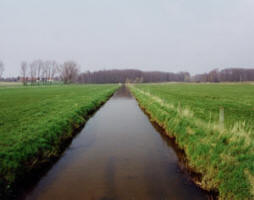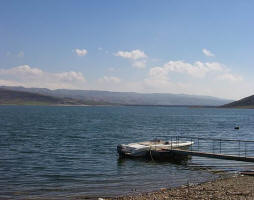 Fog-catching fabric could improve water collection in deserts
Fog-catching fabric could improve water collection in deserts
A novel and affordable fabric may improve the efficiency of water collection from fog, helping to provide freshwater in desert areas.
Researchers from the Eindhoven University of Technology (EUT), in the Netherlands, and Hong Kong Polytechnic University, China, turned a cotton fabric into a water-collecting material by coating it with a polymer called PNIPAAm.
The fabric switches between absorbing moisture directly from the air when it is foggy and cold, and releasing it as water at warmer temperatures, according to a paper to be published on 21 February in Advanced Materials.
Every kilogramme of the sponge-like fabric can absorb around 3.4 litres of water from the air. When the ambient temperature rises, the material's microstructure changes and the water is released. These processes are repeatable, raising hopes the fabric could act as an autonomous water-collecting device.
The team hopes the material could be used to harvest water in dry coastal areas, such as the Namib Desert, in Namibia, where rainfall is scarce but ocean air currents frequently bring vapour-carrying fogs.
The temperature range within which the fabric collects, and then releases, water is similar to the typical daytime highs and night-time lows seen in deserts.
Apart from capturing drinking water from fog in dry mountainous and desert regions, the fabric could have other uses, says Catarina Esteves of EUT.
"One application would be in agriculture," she tells SciDev.Net. "You could mix the coated fibres in the soil where you want to grow plants. At lower temperatures in the evening, it would collect the humidity from the atmosphere. As the temperature goes up the next day, it would release that water into the soil."
The researchers plan to fine-tune the fabric to increase the amount of water that is collected and also to change the air temperatures at which it absorbs and releases water, so it can be used in a wider range of environments.
While cotton is relatively inexpensive and readily available in many areas, Esteves says that more work is required to scale up the team's pocket-sized laboratory samples for practical use in deserts.
The researchers hope to collaborate with companies and other institutions to optimise the material for large-scale production.
Fog-harvesting nylon nets are already used in Chile, Nepal and Peru, but these rely on wind pushing the tiny water droplets that comprise fogs onto them.
The cotton-polymer alternative absorbs water vapour directly from the air and was found to work just as effectively without wind currents in the laboratory tests.
Pilar Cereceda Troncoso of the Pontifical Catholic University of Chile, who has worked on fog collection for 30 years, says that although fog-collecting nets are inexpensive, improving the efficiency of fog collection could "make a great difference".
But Anne Lummerich from the NGO Alimón, which set up fog collectors in Peru, says that in many areas currently using fog collection, fog can settle for weeks or even months, with temperatures not getting high enough for the new fabric to release water.
Shreerang Chhatre, a researcher at the Massachusetts Institute of Technology, United States, says the fabric could be used to "collect an appreciable quantity of water at different locations by tuning the temperature at which this switching occurs".
He says that the use of simple materials might make it cost-effective on a large scale, but adds that the rate at which water is collected and released might limit this technology from being commercialised.
| Contact information |
Joel Winston / Advanced Materials doi: 10.1002/adma.201204278 (2013)
|
|---|---|
| News type | Inbrief |
| File link |
http://onlinelibrary.wiley.com/doi/10.1002/adma.201204278/abstract |
| Source of information | SciDev.Net / Copyright © 2013 WILEY-VCH Verlag GmbH & Co. KGaA, Weinheim / Advanced Materials doi: 10.1002/adma.201204278 (2013) |
| Keyword(s) | water collection in deserts |
| Subject(s) | HYDRAULICS - HYDROLOGY , MEASUREMENTS AND INSTRUMENTATION , METHTODOLOGY - STATISTICS - DECISION AID , NATURAL MEDIUM , RISKS AND CLIMATOLOGY , WATER DEMAND |
| Geographical coverage | n/a |
| News date | 11/02/2013 |
| Working language(s) | ENGLISH |
 you are not logged in
you are not logged in





